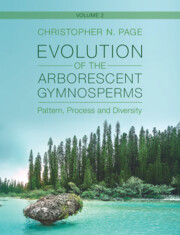Book contents
- Evolution of the Arborescent Gymnosperms: Pattern, Process and Diversity
- Reviews
- Evolution of the Arborescent Gymnosperms
- Copyright page
- Contents
- Preface and Acknowledgements
- Structure of the Volumes
- Part I Aims, Approaches and Diversity
- Part II Phylogenetic Bases and Revised Taxonomic Structure
- Part III Living Arborescent Gymnosperm Genetic Presentations
- Chapter 41 Fitzroya
- Chapter 42 Cryptomeria
- Chapter 43 Glyptostrobus
- Chapter 44 Taxodium
- Chapter 45 Sequoia
- Chapter 46 Sequoiadendron
- Chapter 47 Metasequoia
- Chapter 48 Cunninghamia
- Chapter 49 Taiwania
- Chapter 50 Athrotaxis
- Chapter 51 Araucaria
- Chapter 52 Wollemia
- Chapter 53 Agathis
- Chapter 54 Podocarpus
- Chapter 55 Retrophyllum
- Chapter 56 Nageia
- Chapter 57 Afrocarpus
- Chapter 58 Dacrydium
- Chapter 59 Dacrycarpus
- Chapter 60 Falcatifolium
- Chapter 61 Acmopyle
- Chapter 62 Halocarpus
- Chapter 63 Lagarostrobos
- Chapter 64 Manoao
- Chapter 65 Parasitaxus
- Chapter 66 Prumnopitys
- Chapter 67 Sundacarpus
- Chapter 68 Pectinopitys
- Chapter 69 Microcachrys
- Chapter 70 Pherosphaera
- Chapter 71 Phyllocladus
- Chapter 72 Saxegothaea
- Chapter 73 Lepidothamnus
- Part IV From Ecosystem Services to Conservation and Sustainability
- Selected Bibliography
- Genus Index
- Plate Section (PDF Only)
- References
Chapter 52 - Wollemia
Araucariales: Agathaceae
from Part III - Living Arborescent Gymnosperm Genetic Presentations
Published online by Cambridge University Press: 11 November 2024
- Evolution of the Arborescent Gymnosperms: Pattern, Process and Diversity
- Reviews
- Evolution of the Arborescent Gymnosperms
- Copyright page
- Contents
- Preface and Acknowledgements
- Structure of the Volumes
- Part I Aims, Approaches and Diversity
- Part II Phylogenetic Bases and Revised Taxonomic Structure
- Part III Living Arborescent Gymnosperm Genetic Presentations
- Chapter 41 Fitzroya
- Chapter 42 Cryptomeria
- Chapter 43 Glyptostrobus
- Chapter 44 Taxodium
- Chapter 45 Sequoia
- Chapter 46 Sequoiadendron
- Chapter 47 Metasequoia
- Chapter 48 Cunninghamia
- Chapter 49 Taiwania
- Chapter 50 Athrotaxis
- Chapter 51 Araucaria
- Chapter 52 Wollemia
- Chapter 53 Agathis
- Chapter 54 Podocarpus
- Chapter 55 Retrophyllum
- Chapter 56 Nageia
- Chapter 57 Afrocarpus
- Chapter 58 Dacrydium
- Chapter 59 Dacrycarpus
- Chapter 60 Falcatifolium
- Chapter 61 Acmopyle
- Chapter 62 Halocarpus
- Chapter 63 Lagarostrobos
- Chapter 64 Manoao
- Chapter 65 Parasitaxus
- Chapter 66 Prumnopitys
- Chapter 67 Sundacarpus
- Chapter 68 Pectinopitys
- Chapter 69 Microcachrys
- Chapter 70 Pherosphaera
- Chapter 71 Phyllocladus
- Chapter 72 Saxegothaea
- Chapter 73 Lepidothamnus
- Part IV From Ecosystem Services to Conservation and Sustainability
- Selected Bibliography
- Genus Index
- Plate Section (PDF Only)
- References
Summary
Medium-sized evergreen, soft-leaved, monoecious rainforest trees, to 25–30+ m when mature, with approximately whorled branch systems and a slender, more or less parallel to conic crown. Their shoot and branch systems are moderately stout, mostly markedly spreading-descending. The lateral shoots with age eventually terminate in small, elongate male or orbicular female cones directly from ultimate branches.
- Type
- Chapter
- Information
- Evolution of the Arborescent GymnospermsPattern, Process and Diversity, pp. 267 - 283Publisher: Cambridge University PressPrint publication year: 2024

